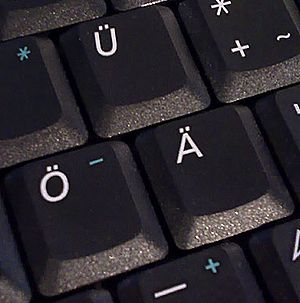Umlaut facts for kids
The umlauts are a group of special letters used in the German language. They look like regular vowels (a, o, u) but have two dots placed above them. These dots are called a diaeresis. The letters with umlauts are written as ä, ö, and ü. Sometimes, when you can't type these special letters, they are written as "ae," "oe," or "ue" instead.
What are Umlauts?
Umlauts are not just decorations; they change how a letter sounds. When you see the two dots over a vowel, it means you need to pronounce it differently.
- Without the dots, the letter 'a' sounds like the 'a' in "father."
- With the dots (ä), it sounds more like the 'e' in "bed."
- Without the dots, the letter 'o' sounds like the 'o' in "go."
- With the dots (ö), it sounds like the 'i' in "bird" or the 'u' in "fur" (but with rounded lips).
- Without the dots, the letter 'u' sounds like the 'oo' in "moon."
- With the dots (ü), it sounds like the 'ew' in "few" (but with rounded lips).
These sound changes are very important in German because they can change the meaning of a word. For example, "schon" means "already," but "schön" means "beautiful."
Umlauts in English
When German words that have umlauts are used in English, the letters are usually written as "ae," "oe," or "ue" instead of ä, ö, or ü. This is because English keyboards don't usually have the umlaut keys.
For example:
- The German word for "beautiful" is schön. In English, it might be written as schoen.
- The German word for "foot" is Fuß (which uses a special 'ß' letter, but its plural is Füße). In English, the plural might be written as Fuesse.
Related pages


